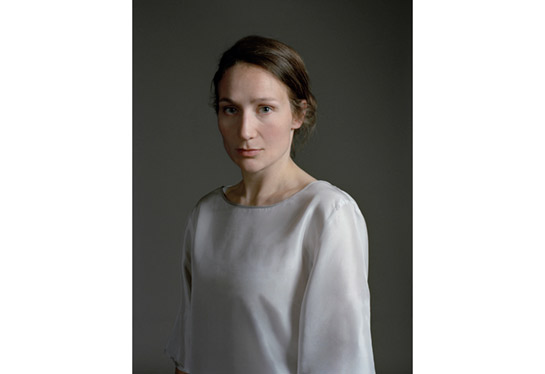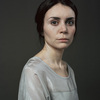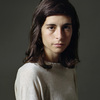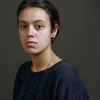A Conversation with CPC 2011 Winner Mirjana Vrbaski

Mirjana Vrbaski’s Verses of Emptiness was picked by Caroline von Courten as one of the winners of this year’s Conscientious Portfolio Competition. About the work, Caroline writes “These very simple and yet dense complex photographs invite me to look more closely and to have a conversation in my mind with these photographs and the persons portrayed.” and “Here the limitation and the concentration of the photographic medium reveal themselves at once in an extraordinary way.” I talked with Mirjana about her work in a conversation that you can find below. (more)
Jörg Colberg: In your biography, it says that your portraiture “revolves around the portrait as a way of exploring innocence.” Can you talk a little bit what you’re trying to achieve?
Mirjana Vrbaski: I try to explore the portrait not as a way of representing a specific person who is sitting in front of the camera, but as a way of portraying a more universal, iconic expression. Trying to capture the model’s personality and character feels at the same time too confining and too impossible to me. It also renders the image uninviting. I believe that talking just about the model’s character is too superficial, because we can never - not in real life and especially not in a two-dimensional image - grasp something as complex as a human personality. In this sense, I don’t see the portrait as having to do with the individual shown on it, but as being a completely new territory, an amalgamation of the model, the photographer and the viewer. An image of a person that doesn’t exist but does resonate a familiar feeling or atmosphere.
Because of this, my process is mostly based on removing ‘classifiable’ attributes my model chose for herself (for example, labeled clothing or modern hairstyles). This minimizing of visual codes helps me get to a more essential, elementary feeling, to something almost archetypical.
JC: I’d be happy to argue that in general clothes don’t make you a person, though (the fashion industry might disagree). That aside, I’m curious why you’re interested in what you call “the essential and elementary,” and how you then work on bringing that out?
MV: Clothes don’t make a person but in a two-dimensional medium such as photography, the viewer has much less to go on when forming his interpretation than s/he does in real life. We can’t hear the model talk or interact with her, so we base our reaction on what we see, on our accumulated experiences and memory, and on our standard ways of classifying. I guess what I’m saying is that I try to eliminate context in my images. Our choices related to our appearance (clothes, style etc) do communicate a sort of belonging, belonging to a type, class or ‘genre’ of a person. I am interested in suspending such traits of belonging so that the image - as much as that is possible - stops being informative and becomes more of a silent, meditative ‘space’. This ties in with the notion of the ‘essential and elementary’. Silence, nothingness and emptiness are elementary. It is out of those states that all further meaning gets constructed and yet they remain essentially mystical.
JC: And what is the allure of the icon? We live in the age of the celebrity - and those people are often considered to be icons. But I’m assuming that’s not what you’re after?!
MV: No, I’m interested in iconography in the traditional sense, and in particular in the way icons are made. Old Byzantine icons and their contemporary Christian Orthodox versions are painted according to a strict protocol, which instructs iconographers to paint all saints in a uniform, generic way, so that you can hardly distinguish one saint from another. If I asked somebody to describe Virgin Mary’s face, they would probably have a hard time and I probably wouldn’t be able to pick her out of a crowd, unless I was told that she has a baby in her arm. And yet she is so real to so many people and touches them in such a profound way. For the same reason, the face of Christ was conceived as particularly uncharacteristic and general by the Byzantines. This generalizing behind iconography interests me because it has to do with that ‘emptying’, with conscious reduction to a bare minimum, with removing specifics and characteristics, so as to allow things to lift themselves beyond the immediate and the mundane.
JC: I’m a bit curious about your process, about the taking of a portrait. How do you prepare for one? How do you work towards the final photograph?
MV: The most important and the most difficult part of my process is finding the right models. It is really important for me that the persons I choose to photograph move something very fundamental in me. Seeing that I approach strangers after having passed them by or seen them for a moment or two, it’s hard to pinpoint what it is that moves me. But I think it has to do with their honesty, with them seeming pure and ‘true’ to me. The rest of the process is just searching. I am very insecure when I photograph and my portrait sessions are usually 1-2 hour highly concentrated searches for a look, an atmosphere or a gesture that reinforces that feeling of honesty and truth. I never know in advance where and whether I will find this.
JC: So you don’t know in advance what you will get out of a person or how to get it out of the person, you just know there is something there?
MV: Usually, all I can do is hope that the feeling I had when choosing the model was right and that the portrait will be successful. I make dozens of portraits before I am able to select a few that work. Often, I am moved by the model when I approach her but her image just doesn’t seem to contain the qualities I talked about above. I think a good photograph is always a combination of skill and luck, and a photographer’s whole process is much less controlled than we like to think. The best photographs I made happened when I stopped trying to control.
JC: I might as well ask you what I asked a large number of photographers before: What makes a great portrait?
MV: For me, a great portrait is one that surpasses the person it depicts and captures something of the mystery that we are to one another. As I said at the beginning, I don’t think it’s possible to know another person in their totality. So in a sense, there will always be an element of an enigma between people, in real life and in imagery. I think that a good portrait communicates a familiar feeling and yet is ambiguous enough for the viewer to be able to engage with that enigma.
JC: Maybe giving an example (or two) might help? Thinking about other photographer’s portraits are there any that you can’t get out of your head?
MV: I love Gerhard Richter’s portraits. They seem to be of actual people yet they’re always very mysterious and distant.
JC: Who are some of your influences as an artist?
MV: My influences change often. But I’m always amazed by artist like Hiroshi Sugimoto, Andreas Gursky, and Tony Scherman, who combine very powerful emotional impact with incredible vision and technique, and who have a refined ability to combine these three elements in a balanced way.
 By
By 






